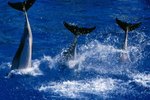
Bottlenose dolphins are mammals found in temperate and tropical waters of the Atlantic, Pacific and Indian oceans and their rivers, bays and estuaries. Two different ecotypes exist; each type has its own behaviors, habitats and prey. Coastal bottlenose dolphins and offshore bottlenose don't socialize with each other. Some bottlenose dolphins shift to warmer waters when temperatures drop or food supplies migrate.
Physical Characteristics of the Bottlenose Dolphin
The bottlenose dolphin's head is rounded with a lateral crease on his forehead. He's recognized by his well-defined, upturned beak and a curved mouth that appears to smile. The bottlenose dolphin's body is sleek and tapered, with smooth, thick and rubbery skin. It ends in two flukes used to propel his movements. He steers with his forelimbs, called pectoral fins, and breathes through a single blowhole. His body temperature is regulated by a dorsal fin extending from the center of his back.
The Coastal Bottlenose Dolphin
Coastal bottlenose dolphins are more prevalent than offshore bottlenose. They tend to remain within 5 miles of the shoreline, where the water is shallow and warm. Coastal bottlenose weigh between 300 and 650 pounds and may be from 6 to 10 feet long. Their bodies are smaller than offshore types, but their flippers are larger. Coastal bottlenose dolphins are sometimes found in bays and estuaries searching for prey. Some, but not all, migrate to warmer waters.
The Offshore Bottlenose Dolphin
Offshore bottlenose dolphins are genetically different from coastal dolphins, and are darker in color. They prefer the cooler waters found farther from the coast. Larger and more powerfully built, they can weigh up to 1,100 pounds and grow up to 14 feet long. Most offshore dolphins are migratory. In the United States they are found in southern California, from New York south to the Florida Keys, and from Florida to the Gulf of Mexico.
Unusual Migratory Patterns
Bottlenose dolphins don't engage in a mass migration at a specific time. Some, but not all bottlenose will migrate south during colder temperatures. Offshore bottlenose dolphins live farther north and migrate in larger numbers than the coastal type. Northern migratory dolphins travel to southern North Carolina when escaping the cold, while southern migratory bottlenose winter from South Carolina to Florida. Bottlenose dolphins also travel when they're in pursuit of migrating prey.
References
Photo Credits
-
Tom Brakefield/Stockbyte/Getty Images
Writer Bio
Karen Mihaylo has been a writer since 2009. She has been a professional dog groomer since 1982 and is certified in canine massage therapy. Mihaylo holds an associate degree in human services from Delaware Technical and Community College.




